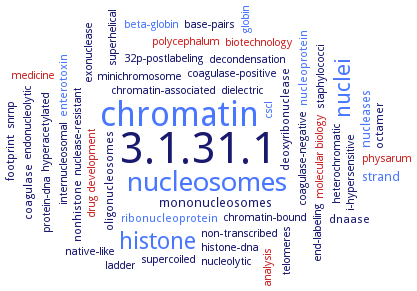3.1.31.1: micrococcal nuclease
This is an abbreviated version!
For detailed information about micrococcal nuclease, go to the full flat file.

Word Map on EC 3.1.31.1 
-
3.1.31.1
-
chromatin
-
nucleosomes
-
histone
-
nuclei
-
strand
-
nucleases
-
mononucleosomes
-
dnaase
-
deoxyribonuclease
-
footprint
-
coagulase
-
nucleoprotein
-
enterotoxin
-
nonhistone
-
oligonucleosomes
-
octamer
-
ribonucleoprotein
-
polycephalum
-
chromatin-associated
-
non-transcribed
-
medicine
-
protein-dna
-
globin
-
staphylococci
-
native-like
-
internucleosomal
-
hyperacetylated
-
snrnp
-
telomeres
-
nuclease-resistant
-
32p-postlabeling
-
decondensation
-
physarum
-
minichromosome
-
chromatin-bound
-
endonucleolytic
-
coagulase-positive
-
coagulase-negative
-
end-labeling
-
histone-dna
-
beta-globin
-
drug development
-
molecular biology
-
superhelical
-
supercoiled
-
exonuclease
-
dielectric
-
analysis
-
i-hypersensitive
-
ladder
-
base-pairs
-
biotechnology
-
cscl
-
heterochromatic
-
nucleolytic
- 3.1.31.1
- chromatin
- nucleosomes
- histone
- nuclei
- strand
- nucleases
-
mononucleosomes
- dnaase
- deoxyribonuclease
-
footprint
- coagulase
- nucleoprotein
- enterotoxin
-
nonhistone
-
oligonucleosomes
-
octamer
- ribonucleoprotein
- polycephalum
-
chromatin-associated
-
non-transcribed
- medicine
-
protein-dna
- globin
-
staphylococci
-
native-like
-
internucleosomal
-
hyperacetylated
-
snrnp
-
telomeres
-
nuclease-resistant
-
32p-postlabeling
-
decondensation
- physarum
-
minichromosome
-
chromatin-bound
-
endonucleolytic
-
coagulase-positive
-
coagulase-negative
-
end-labeling
-
histone-dna
- beta-globin
- drug development
- molecular biology
-
superhelical
-
supercoiled
-
exonuclease
-
dielectric
- analysis
-
i-hypersensitive
-
ladder
-
base-pairs
- biotechnology
- cscl
-
heterochromatic
-
nucleolytic
Reaction
endonucleolytic cleavage to nucleoside 3'-phosphates and 3'-phosphooligonucleotide end-products =
Synonyms
AtTSN1, AtTSN2, cTSN, EC 3.1.4.7, Epstein-Barr virusencoded transcription factor 2 co-activator p100, HsTSN, micrococcal DNase, micrococcal endonuclease, Micrococcal nuclease, MN, MN ase, MNase, Nuc, NUC1, Nuc2, nucB, nuclease 8V, nuclease T, nuclease T', nuclease, micrococcal, nuclease, staphylococcal, NucM, P100, PaTSN, PfTSN, ribonucleate (deoxyribo-nucleate) 3'-nucleotidohydrolase, ribonucleate (deoxyribonucleate) 3'-nucleotidohydrolase, S. aureus nuclease, SNA, snake venom phosphodiesterase, SNase, SNAseR, SND1, spleen endonuclease, spleen phosphodiesterase, staph nuclease, staphylococcal nuclease, Staphylococcal nuclease A, Staphylococcal nuclease domain containing-1, staphylococcal nuclease domain-containing 1, staphylococcal nuclease domain-containing protein 1, staphylococcus aureus nuclease, staphylococcus aureus nuclease B, Staphylococcus aureus nuclease homologue, thermonuclease, TNase, TSN, tudor staphylococcal nuclease, Tudor-SN, Tudor-staphylococcal nuclease


 results (
results ( results (
results ( top
top





